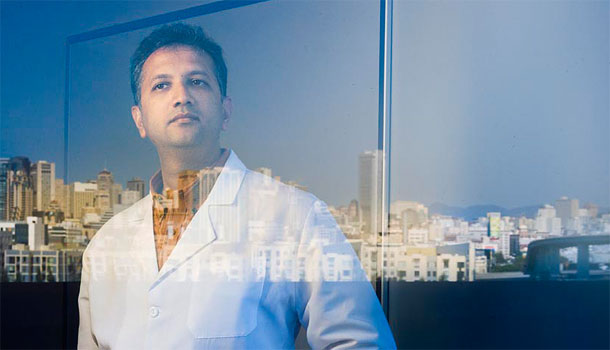
Shuvo Roy
Bioengineering and Therapeutic Sciences
San Francisco
Chronic kidney failure threatens about half a million people in the U.S. alone. Donated kidneys can restore health, but they are in are in short supply. As a result, some 350,000 people with failing kidneys are tethered to dialysis machines several days a week – a tiring, uncomfortable and expensive treatment, and one that falls far short of performing a normal kidney’s functions.
Shuvo Roy, a professor in the UCSF Department of Bioengineering and Therapeutic Sciences, and his colleagues are developing an implantable, fully functional artificial kidney.
Question:
So many people are on dialysis. Why do you consider dialysis inadequate?
Answer:
A healthy kidney rids the body of excess water and the buildup of urea and other nitrogenous wastes – major byproducts of the body’s metabolism of protein. Dialysis is only about 13% as efficient as a normal kidney at filtering out toxins. And dialysis fails at the kidney’s other essential functions, like helping regulate blood pressure and secreting hormones.
Question:
It sounds like dialysis is not the answer.
Answer:
Only about a third of dialysis patients survive more than five years. And the cost is not only in lives. The U.S. spends about $35 billion a year on kidney-failure patients, and much of it is paid for by Medicare. We can do a whole lot better. This is the goal of what we call bio MEMS -- biomedical micro-electro-mechanical systems -- joining biomedicine with micro-scale engineering, and taking advantage of advances in silicon materials fabrication. An implantable artificial kidney is just one possibility. My colleagues and others are working on improved drug delivery and better bone implants. This has great potential to improve lives and reduce health care costs.
Question:
How does the artificial kidney work?
Answer:
It has two parts to mimic the two main functions of the normal kidney. We have adapted fabrication technologies that are used to produce microelectronics in Silicon Valley, and applied them to create nanoscale pores in silicon membranes that can filter the blood much as a healthy kidney does. The process is “powered” simply by blood pressure. No artificial pumps or electrical power are needed.
Question:
How far along are you in developing the implantable artificial kidney?
Answer:
We have developed the fabrication technologies needed to reduce the size of the device so that it will fit into patients’ bodies. The individual components have been shown to work in animals. We are now about five years away from the first human patients.
Question:
Where would it be placed, and how would you expect the body to respond to an artificial organ?
Answer:
The artificial kidney would be implanted in the abdomen, in the same area where a transplanted kidney is located. Because of size of nanoscale pores in the silicon membranes, the engineered kidney cells are protected from rest of the patient’s body, and will not provoke an immune reaction. The engineered kidney would perform much as a normal kidney does, ridding the body of toxins and maintaining normal metabolism.
Question:
Does the filtering capacity of the silicon membranes have other applications?
Answer:
We have had interest from medical device companies, and from NASA. When someone is given an injection, the solution must include highly purified water, called medical grade water. It has to be free of endotoxins - sugar-like molecules produced by bacteria. We worked with NASA to show that our membranes can be used to generate that highly purified water from other sources in the space shuttle.
Question:
You started developing this project at the Cleveland Clinic, and then joined the UCSF faculty three years ago. Why did you choose to come to UC?
Answer:
Of course the strength of UCSF’s medical research and clinical work was a big factor. I also have an appointment in the joint graduate program in bioengineering with UC Berkeley, one of the top engineering research universities in the world. So, it’s a great synergy for developing new ways to deliver nano- and micro-scale biomedical solutions.